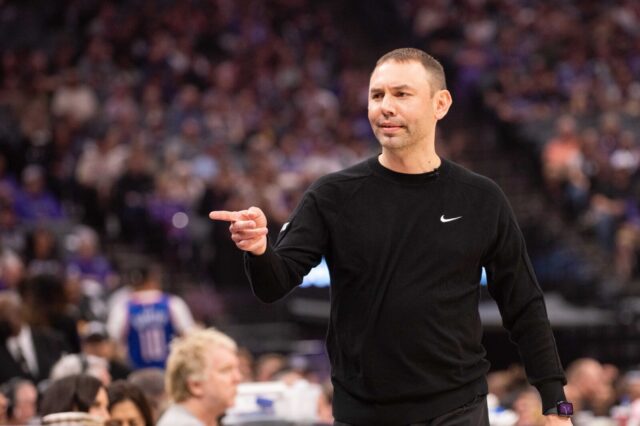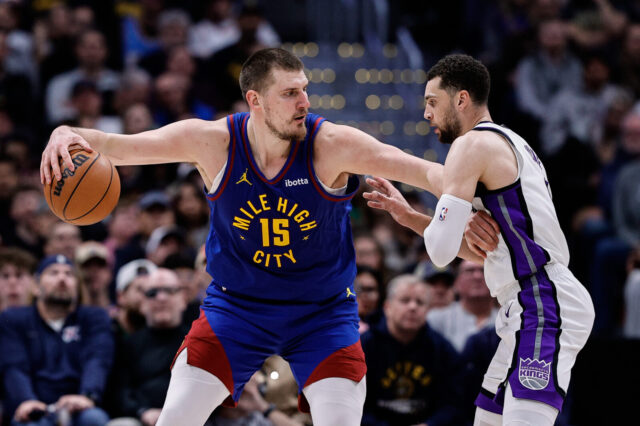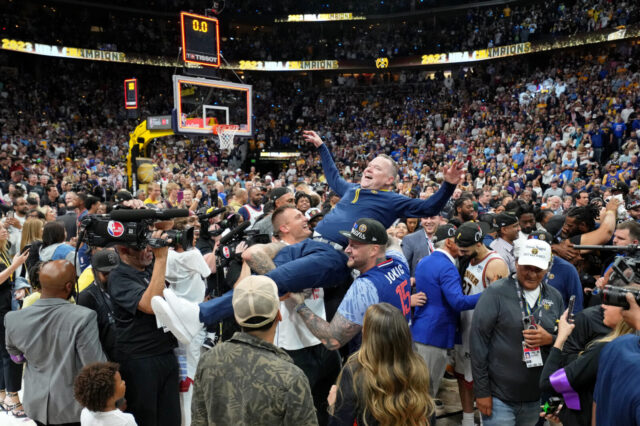If there’s one aspect of the off-season that I’m supremely interested in seeing what the Denver Nuggets do now that Tim Connelly is gone, it’s the NBA Draft. Connelly has been in charge of the Nuggets draft classes since 2014, and it was by far his best trait as Denver’s lead decision maker. The Nuggets had far more hits than misses, and Connelly had a type: skilled shooters with a high basketball IQ. Now, with Calvin Booth presumably in charge, how will Denver’s draft process evolve and change?
In the 2022 NBA Draft class, there are several prospects in the second round that have the potential to fill interesting, unique roles at the next level. One such player is Alabama wing Keon Ellis, a skinny, 6’6” point-of-attack defender with an exceptional three-point shot. At 22 years old, Ellis played JUCO at Florida SouthWestern State College for two years before ultimately transferring to Alabama. He played a bench role last year behind Herbert Jones before stepping into a full-time starting role this year. He made life hell for guards all around the SEC on his way to an SEC All-Defensive Team award, and he made 67 threes in 33 games as a senior.
He’s a unique prospect, one that’s gone under the radar a bit but could certainly be a high quality NBA defender sooner rather than later. Should he interest the Nuggets at 21st overall? Probably not. But later in the draft? Definitely.
Vitals
Height: 6’5.75”
Weight: 167 lbs
Wingspan: 6’8.5”
Age: 22 years old on draft night (1/8/2000)
Keon Ellis’s Senior Season Per Game Statistics
Keon Ellis averaged 12.1 points, 6.1 rebounds, and 1.8 assists in 30.9 minutes per game in his senior season at Alabama. He also added 1.9 steals and 0.6 blocks per game, and those 2.5 “stocks” are a fairly high number in comparison to the rest of the 2022 draft class. As far as the shooting efficiency, Ellis was fairly efficient on lower volume, hitting 57.9% on his two-pointers, 36.6% of his three-pointers, and a stellar 88.1% of his free throws.
Strengths
Defensive playmaker on and off-ball
The first thing that stands out with Keon Ellis is his ability to guard on the perimeter. At close to 6’6” with a 6’8” wingspan, Ellis was one of the leading perimeter defenders in the SEC last year, winning All-Defense for his efforts. The last Alabama defender to win a defensive award: Herbert Jones. Ellis conjures up a similar picture with his long arms and willingness to harass lead ball handlers and shooters up and down the court.
Ellis had a 3.4% steal rate and a 2.1% block rate in his Alabama tenure, both elite numbers for a point-of-attack defender. He was a defensive playmaker and sought out opportunities to make plays with his quick feet, quick hands, and strong defensive instincts.
He wasn’t just a “stocks” hunter though. He made defensive plays within the flow of the game and was able to impact the game as a positional defender. He stays in front of the ball really well and recovers around picks very quickly, staying attached to his man and making shot attempts difficult whenever he’s in the vicinity.
Off ball, Ellis likes to sag off of his defensive assignment to clog the lane and be a pest. He can do it because he’s quick enough to recover to the perimeter again, but also because he keeps his head up and has good feel for where the ball is going to go.
Ellis also does a good job of getting skinny on screens, and that forces a ton of offensive fouls with him sticking so close to his assignment most of the time.
Ellis is certainly lighter and has less bulk to weather the storm against professional players, but there’s little doubt that his defensive instincts and overall thievery will translate to the professional level if given an opportunity.
Catch-and-shoot threat
Ellis played next to multiple ball handlers and scorers at Alabama and was mostly relegated to a supporting role as a floor spacer. Alabama emphasized three-point shooting and floor spacing heavily, and that’s exactly what Ellis did. He hit 36.6% of his threes this year and demonstrated a willingness to let shots fly quickly.
Even when Ellis was contested, he often trusted his three-point shooting and made some really impressive outside shots in high pressure moments. His patience and balance are essential in his ability to reload for three.
And another from the same game: he was absolutely on fire against Kentucky. He had defenders flying all over the place.
Watch Ellis for this entire sequence and how he’s hunting for an open shot, and then watch John Calipari’s reaction on the sidelines. Absolute gold.
Ellis wasn’t the most efficient three-point shooter ever (37.1% for his college career) but he did shoot 88.1% from the free throw line this last year. He has all of the indicators of being a good to great catch-and-shoot guy at the next level.
Athletic driver
Because Ellis was more of a spot up guy, it wasn’t showcased as often just how athletic he could be. The Alabama wing can get up there though, and he had some really impressive drives and dunks off of pump fakes and blow by’s, but also as a finisher in transition. Ellis shot 57.6% on two-pointers this year (relatively low volume) but a lot of that was due to his exceptional finishing at and above the rim. He can do the fundamental stuff with the ball that an off-ball wing needs to do in order to stay on the floor.
Durability
Apparently, Keon Ellis has never missed a game or a practice at Alabama due to illness or injury. That’s great to hear, and it’s not to say that he wasn’t sick or hurt at any point during his tenure there, but rather that he fought through it. He’s clearly a gamer and a competitor who’s willing to put in the work and loves what he does. That comes across the tape in the way he competes on defense. It’s more of a tiebreaker piece of this than anything.
Weaknesses
Lighter, skinny frame
It’s pretty easy to see why this could be a problem for a player that projects to play on the wing at the next level. At the NBA Draft Combine, Ellis weighed in at 167 pounds. As a matter of comparison, Bones Hyland weighed in at 169 pounds in last year’s combine. Bones was able to make it work as a defender at the point guard position, but switching him onto wings and forwards often resulted in mismatches in the paint and on the boards.
Ellis is in much the same boat, and he doesn’t have the dynamic dribbling and playmaking skills that Bones has to play point guard all the time. He will be liable to some of the same issues at the NBA level.
Now, it doesn’t mean that a creative team can’t make use of him, but it requires Ellis to be adaptable and willing to play a bit role at times. He will probably be fine with that, but it limits the ceiling of what he can be for most teams.
Off the dribble skills
On top of being a smaller guy, Ellis isn’t great with the ball in his hands. His pull up jumper was poor at the college level, and it started with his mechanics. He clearly wasn’t very comfortable taking shots off of more than one rhythm dribble.
When going to the basket, Ellis is comfortable as a straight line driver and occasionally throws in a euro step at the end to create space for a shot. When asked to do much more than that as a scorer though, he often struggled.
More and more in the NBA, role players are being phased out, and almost every position is required to be a capable dribbler, passer, and shooter. There’s no question that Ellis has the shooting down, but if defenses close out quickly enough to him, he often gives back the ball to his college teammates without much of a dribble move. Will that fly at the next level for more than 15 to 20 minutes per game? Probably, but it puts a ceiling on what he can be.
Playmaking for others
Much like the off-the-dribble discussion, Ellis very rarely is put into a position where he has to see the floor and make the correct passing read, especially something that’s more than just a swing pass around the perimeter. He didn’t have a ton of experience at Alabama playmaking for others, and that will certainly show up more at the NBA level. Whether it’s a big deal for an off-ball guard remains to be seen.
Verdict
The Denver Nuggets are hoping to improve their perimeter defense in any way they can this summer, and if they’re truly serious about it, they will draft snd develop elite defenders of their own. They’ve long focused on offense and shooting in the draft, but in order to round out the roster, they will need to take some chances and get more creative.
Keon Ellis certainly represents taking a chance. He’s already 22 years old and hasn’t shown much ability to create his own shot or shots for others as a guard weighing 167 pounds. It’s very rare for those types of players to stick in the NBA. But Keon Ellis sure can play defense with the best of them. He was absolutely deadly as a defender when deployed correctly, and his best skill (point-of-attack defense) is Denver’s biggest weakness. The Nuggets also have ball handling and playmaking guards that can make up for Ellis’ deficiencies offensively, along with Nikola freaking Jokić as their center. They can survive a non-creator on offense.
Can Keon Ellis play shooting guard at the next level? Perhaps if he bulks up a bit. He’s already pretty muscular for his frame though, and it’s fair to wonder just how much heavier he can get. Even 180 pounds probably isn’t heavy enough to be truly switchable at the NBA level, and that could be difficult when defending players like Luka Doncic, Klay Thompson, Jimmy Butler, and other bigger wings.
To me, Ellis seems like a player that should be drafted in the second round by a team willing to take a flyer. He’s a good outside shooter and a great defender, and if the concerns about his frame are overblown, he has the makings of a value 3&D wing at the next level. If he falls out of the draft entirely, the Nuggets should absolutely look to add him to their summer league team and attempt to get him on a two-way contract (or even a guaranteed contract as an undrafted free agent). That feels like the right place for Ellis to be heading into the NBA, and it would make sense for the Nuggets to be interested in his services.


